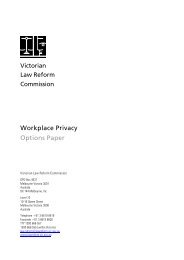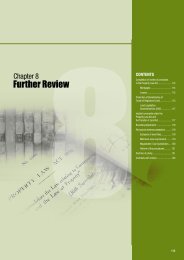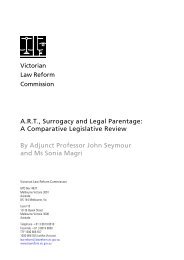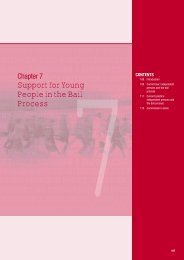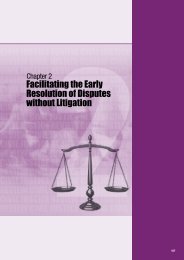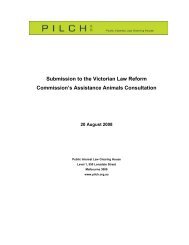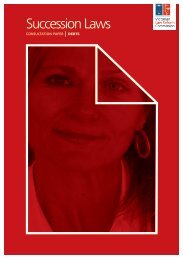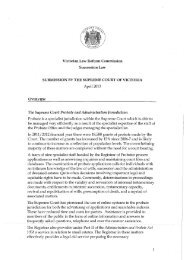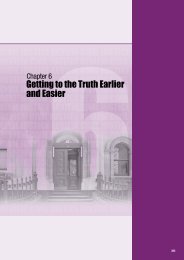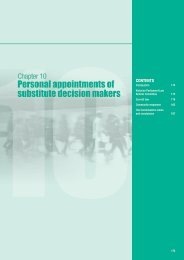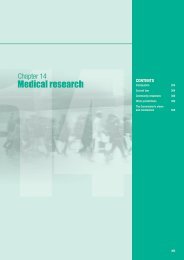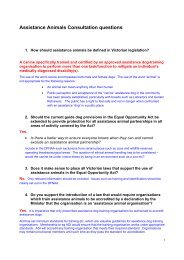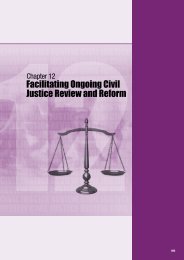Crimes Mental Impairment consultation paper.pdf - Victorian Law ...
Crimes Mental Impairment consultation paper.pdf - Victorian Law ...
Crimes Mental Impairment consultation paper.pdf - Victorian Law ...
Create successful ePaper yourself
Turn your PDF publications into a flip-book with our unique Google optimized e-Paper software.
<strong>Victorian</strong> <strong>Law</strong> Reform Commission<br />
Review of the <strong>Crimes</strong> (<strong>Mental</strong> <strong>Impairment</strong> and Unfitness to be Tried) Act 1997: Consultation Paper<br />
However, it stands in contrast with the presumption that applies to varying orders when<br />
an application is made. In this case, the presumption is in favour of keeping the person on<br />
the custodial supervision order. Section 32(2) of the CMIA provides that the court must<br />
not vary a custodial supervision order to a non-custodial supervision order unless satisfied<br />
that the safety of the person subject to the supervision order or members of the public<br />
will not be seriously endangered.<br />
9.18 In extended leave matters, there is no presumption either way. The court may grant an<br />
application of extended leave if satisfied that the safety of the forensic patient or forensic<br />
resident will not be seriously endangered because of the extended leave. 11<br />
9.19 The existence of different presumptions that apply at various stages of the decisionmaking<br />
process prompts examination of why these differences exist and how they<br />
operate in practice at different stages of review.<br />
Question<br />
87 Are the current presumptions in varying and revoking supervision orders<br />
appropriate<br />
The role of dangerousness<br />
9.20 A significant part of the decision to make, vary or revoke a supervision order or to grant<br />
extended leave hinges on the court’s assessment of the dangerousness of the person<br />
subject to the supervision order. The system currently in place, that permits the detention<br />
of a person based on the likelihood of endangerment, is a system of preventive detention,<br />
justified because of community protection. McSherry says:<br />
There is a presumption that a person who has committed a crime once because of his<br />
or her mental impairment will be driven to do so again. In this sense, those found not<br />
criminally responsible have generally been detained on the basis of ‘dangerousness’. That<br />
is, they are perceived as dangerous individuals who may do harm again. 12<br />
9.21 Justice Cummins set out the process in Re PL:<br />
Predicting dangerousness is notoriously difficult. No guarantees ever can be given. Bearing<br />
in mind that many applicants have killed, the court moves very cautiously. The court<br />
carefully takes into account the circumstances of the original events. On the question of<br />
community safety, the court has regard to the length of time between the events and<br />
the application because the applicant has been found to have committed the relevant<br />
serious actions. The court examines the treatment, insight and progress of the applicant<br />
and considers expert evidence from very experienced medical and other professionals.<br />
It calls upon its own experience of human behaviour and of recidivism and reformation.<br />
Thus the court proceeds with as much responsible data as reasonably can be obtained,<br />
to seek to ensure community safety as contemplated by the [CMIA]. However, it must<br />
be remembered that applicants found not guilty by reason of mental impairment (or<br />
previously insanity) have not been convicted of a crime. Characteristically, they have<br />
suffered from a mental illness. The court’s jurisdiction in that respect is protective. It<br />
should be remembered that ultimately the best protection for the community is that<br />
persons found not guilty by reason of mental impairment are able to return to the<br />
community as useful citizens. 13<br />
9.22 Relying on the risk of endangerment could potentially raise a number of issues.<br />
190<br />
11 Ibid s 57(2).<br />
12 Bernadette McSherry, ‘Legal Issues’ (1999) 6 Journal of <strong>Law</strong> and Medicine 216, 221.<br />
13 Re PL [1998] VSC 209 (15 December 1998) [15].



